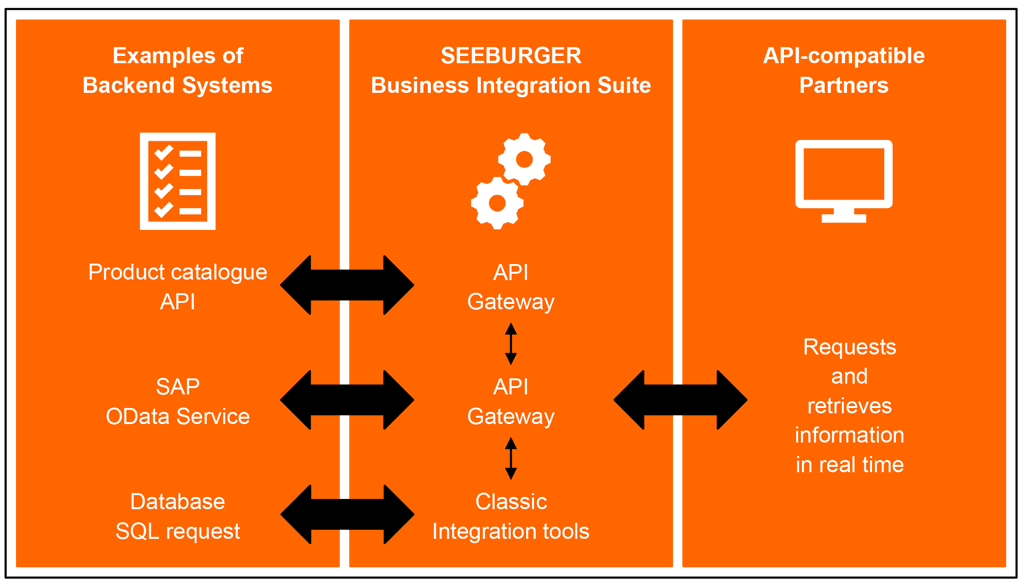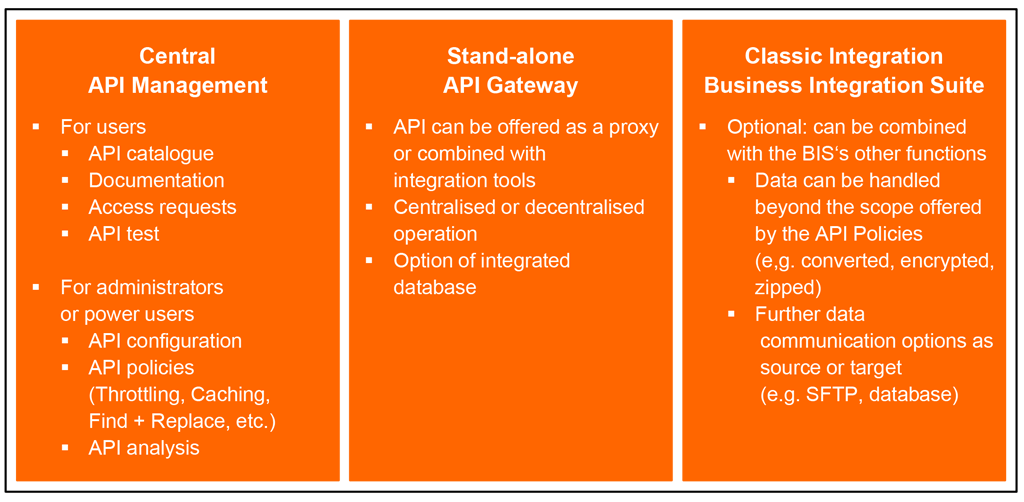
Currently there is a clear – some may even say unquestioning and unavoidable – trend in many areas towards using APIs.
We use APIs several times a day in our personal and professional lives, often unknowingly. This could be directly or indirectly via apps or websites on our smartphones, tablets or laptops, as well as through smart home components such as loudspeakers and temperature sensors.
What an API actually is, has been described beautifully by Thomas Kamper in this SEEBURGER Blog Article.
In a nutshell, an API is an interface which allows data or information to be exchanged in real time including qualified feedback on technical and data level.
Are APIs better than the classic integration technology?
At present, there is a need for both APIs and for classic integration and interface technologies in the OSRAM Business Integration Team’s toolkit. It is like a well-stocked toolbox, which provides the perfect tool available for every situation. In some cases, you need to use a combination of tools.
If a company is highly diversified, or has a long history of evolution and change, it often won’t be possible to only use APIs as interface technology as there are likely to be certain components which aren’t and can’t be made API-compatible.
However, foregoing the advantages of APIs is also not an option for such companies, even those who currently aren’t using any API-compatible components. Sooner rather than later, there’s bound to be a situation which requires an API. This may be a specific customer request, optimising a process, or even just updating existing software.
In such cases, you need a multi-talented integration platform that can deal with classic interface technologies, APIs, and a combination of these.
What can I do with an API?
At this juncture, it would be useful to differentiate between cases only involving APIs and cases in which it is either necessary or at least helpful to combine APIs with classic interface technologies.
Below are some examples of what an API can enable you to do. There are several constellations available that can be tailored to fit a specific situation.

Transferring data: BIS provides API as a Proxy
Here, BIS provides an API which is accessed through the internet or intranet, making information available from an API-compatible source system of your choice.
Changes to the source system, such as new computer names or ports, can be carried out without the API users being affected.
Some examples of how this is used at OSRAM:
- Calling up product information via a product API
- Tracking items via a logistics partner’s API (e.g. from SAP)
- Calling up order details via an OData service in SAP (e.g. from Salesforce)
- Calling up instructions via an OData service (e.g. from a logistics partner)
Combined with Integration: BIS provides an API
Here, BIS provides an API which is accessed through the internet or intranet, giving access to information from an API-compatible or even non API-compatible source system of your choice.
In this scenario, the API is a shell, which can contain various activities.
This could involve accessing a database, a file system, an API or indeed a number of other sources, and the information being modified or converted into a desired format (such as XML or JSON) before being returned to the API.
However, it could also involve accessing several different sources, such as a database and an API. BIS merges the data and converts it to the format you need before being returned to the API
The API consumers won’t be able to recognise where the data has actually come from.
Combined with integration tools: BIS uses an API with a non API-compatible source system
The information retrieved by the API can originate from any number of sources, for example, from a CSV file, which has been sent to the BIS using SFTP. BIS then converts the file into a format typically used by an API, such as JSON or XML, and transfers this to the API making the request. The API’s response is captured and then archived, sent by e-mail, or converted and sent to the source system.
Some examples of how this is used at OSRAM:
- Sending information to financial service providers based on a CSV file from SAP.
(BIS receives the CSV file via SFTP, converts this into JSON and transfers this to the business partner’s REST API) - Sending a dispatch notification to customers based on an SAP DESADV-IDoc
(BIS receives the IDoc through tRFC, converts this into XML and transfers this to the partner’s REST API)
Combined with integration tools: BIS uses an API with a non API-compatible target system
BIS calls up an API either scheduled or on an event basis with a set of defined parameters. The data provided by the API is captured and then archived, sent by e-mail, or converted and sent to a certain target system.
Some examples of how this is used at OSRAM:
- Accessing information from market data providers originating from a JSON file from a REST API
(BIS collects the data at timed intervals, converts this into various target formats such as CSV, XML, database charts, and transfers to various targets such as SFTP, Fileshare, etc.)
Using such an integration platform as the SEEBURGER Business Integration Suite has been the right way forward for OSRAM, giving us the highest possible flexibility.
Alongside the classic integration technologies, there are standard integrated components for both API management and an API gateway.

Using such a platform means that you don’t need to spend time and money building up your own infrastructure, while using new software, implementing new processes or accessing information is all easier, and with a shorter implementation time. This helps to see the need for an API not as an annoying burden, but as an opportunity, helping your company progress.
In conclusion
In today’s business world, APIs should be a hot topic in business integration teams and IT departments in every company.
The newest version of API Management (including API Gateway) being offered by SEEBURGER within its Business Integration Suite is not only a great solution for users of a combination of APIs and classic integration technology. It also holds its own as a stand-alone API management solution.
Only by having a platform to serve API technologies as a business integration service can an IT department future-proof itself.
Source: https://blog.seeburger.com/adding-api-to-your-business-integration-toolkit-a-beginners-guide/
 expertise
expertise

Changes to the source system, such as new computer names or ports, can be carried out without the API users being affected.